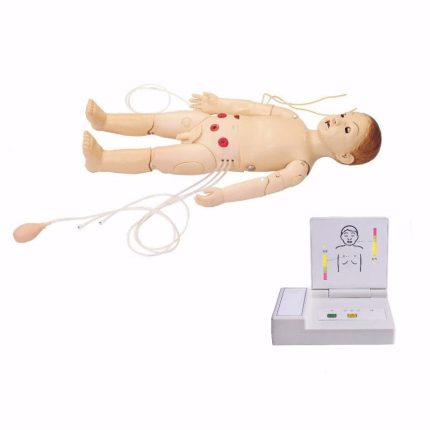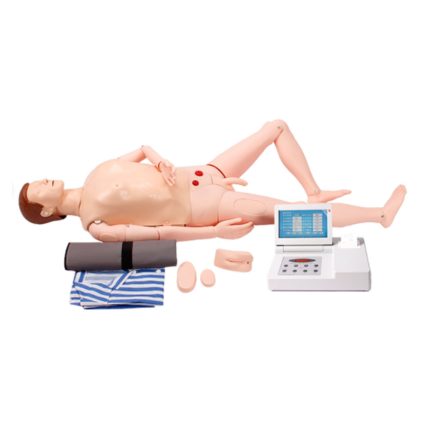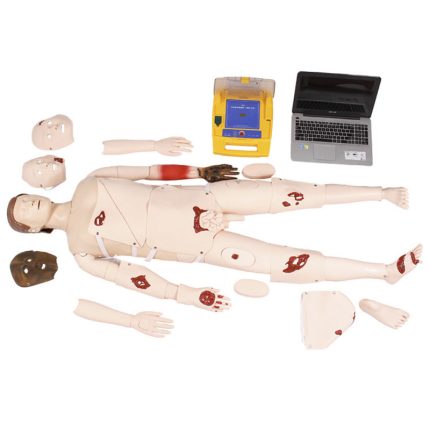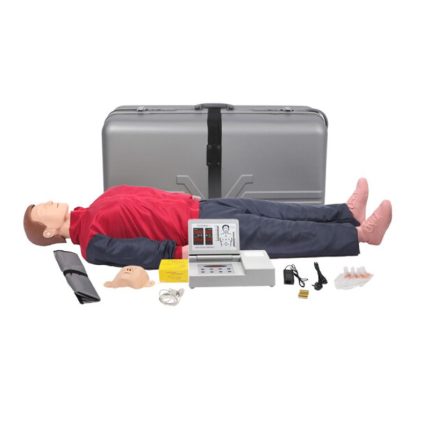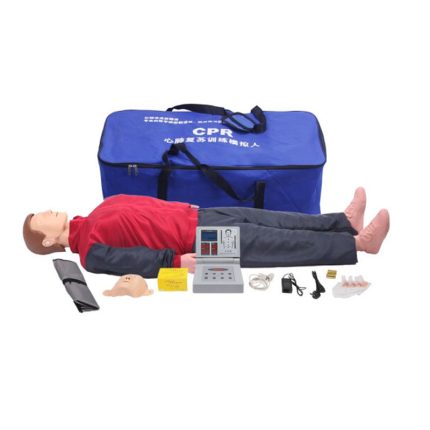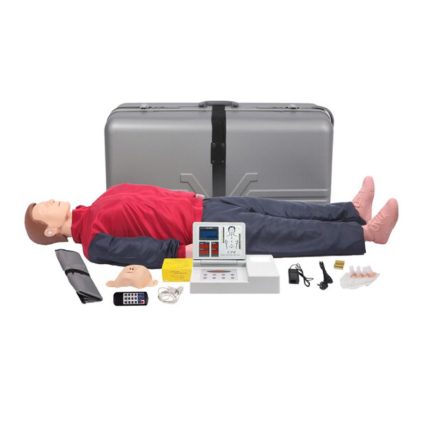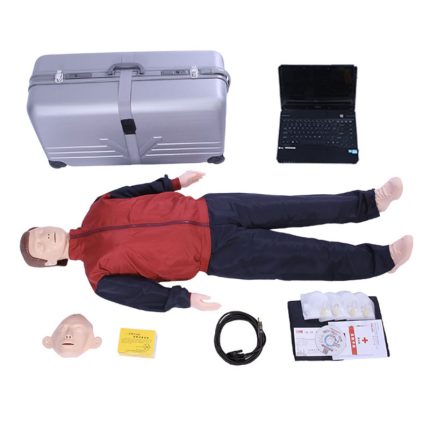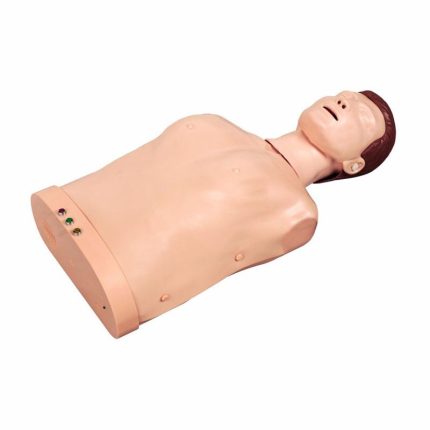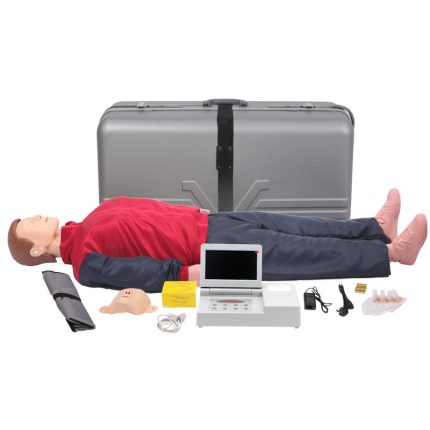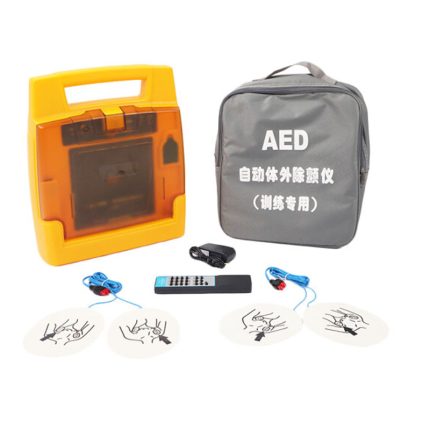Executive Standard: American Heart Association (AHA) 2020 Guidelines for International Cardiopulmonary Resuscitation (CPR)&Cardiovascular First Aid (ECC)
This system provides a comprehensive first aid skills system for children ACLS. It is designed according to human based on the anatomical features and physiological characteristics of five and one year old children. It is suitable for first aid simulation operation in major hospitals, medical schools and health schools. The product is made of imported simulation materials and the system includes a simulated patient, a large colour computer monitor, an AED simulator and a remote control. It can perform a series of first aid means such as cardiopulmonary resuscitation, tracheal intubation, real defibrillation pacing, simulated defibrillation pacing and ECG learning and assessment, providing emergency physicians with easy and practical ACLS training tools.
Features:
■ Vital signs simulation: visual comparison of bilateral pupil dilatation with normal, femoral artery booting.
■ Airway management: realistic mouth, nose, tongue, gums, pharynx, larynx, oesophagus, epiglottis, trachea; transoral tracheal intubation and suctioning can be practised.
■ Intravenous infusion/puncture: arm veins, femoral veins, dorsal foot veins.
■ Intramuscular injections: bilateral deltoids, bilateral lateral femoral muscles.
■ Subcutaneous injections: subcutaneous lateral thigh.
■ Bone marrow puncture: tibial puncture, obvious body marker with simulated bone marrow outflow.
■ Gastric tube insertion: allows gastric lavage, gastrointestinal decompression manoeuvres, supports abdominal auscultation to detect the position of the tube and allows aspiration of gastric fluid after successful insertion.
■ Catheterisation: male/female perineum can be changed and male/female catheterisation is feasible.
■ Colonic, rectal and cystostomy port care.
■CPR operation training: can perform mouth-to-mouth, mouth-to-nose, simple respirator-to-mouth and other ventilation methods; electronic monitoring of airway opening, number of blowing, frequency of blowing, volume of blowing, number of compressions, frequency of compressions, position of compressions and depth of compressions; automatic determination of the ratio of artificial respiration to chest compressions; real-time data display, full Chinese display.
■ Cardiopulmonary auscultation: can cooperate with the simulator to auscultate and identify more than one hundred sound sources, including: normal and abnormal heart sounds, respiratory sounds, bowel sounds and vascular murmurs.
■ ECG monitoring: allows for ECG monitoring functions. Internal storage of 20 types of ECG.
■ Real defibrillation pacing: for use with the self-contained real defibrillation pacemaker.een:
■ Electronic monitoring: the electronic indicator light displays the open and pressed parts of the monitoring airway. The correct and wrong counts of artificial respiration and chest compressions.
■ Voice prompt: Chinese voice prompt throughout the training and assessment can be turned on and off, and the volume can be adjusted.
■ Barcode display air blowing volume: the correct air blowing volume is 500~600ml-1000ml:
• When the air blowing volume is too small, the bar code is yellow.
• When the air blowing volume is appropriate, the barcode is green.
• When the air blowing volume is too large, the barcode is red.
• The tidal volume blown in is too fast or too large, resulting in the indication of gas entering the stomach; Digital counting display; Error language prompt;
■ The bar code displays the pressing depth, and the correct pressing depth is 5-6cm:
• When the pressing depth is too small, the barcode is yellow.
• When the pressing depth is appropriate, the barcode is green.
• When the pressing depth is too large, the barcode is red.
■ The correct rate of operation can be set automatically.
■ You can set the operation time by yourself, in seconds.
■ Operating frequency: the 2020 standard is 100-120 times/minute, and the value can also be set by yourself.
■ Power supply status: 220V power supply is adopted, and 12V power supply is output after voltage stabilization by voltage regulator. (Lithium battery can be added for direct use without external power supply)
Standard Set Configuration:
■ Highly intelligent ACLS five year old child simulator
■ SA/S7 blood pressure measurement training device
■ Cardiopulmonary auscultation simulation kit
■ ECG generator
■ Defibrillation transducer
■ CPR monitors
■ Simple ventilator, stethoscope, pharyngoscope, tracheal cannula, infusion set


